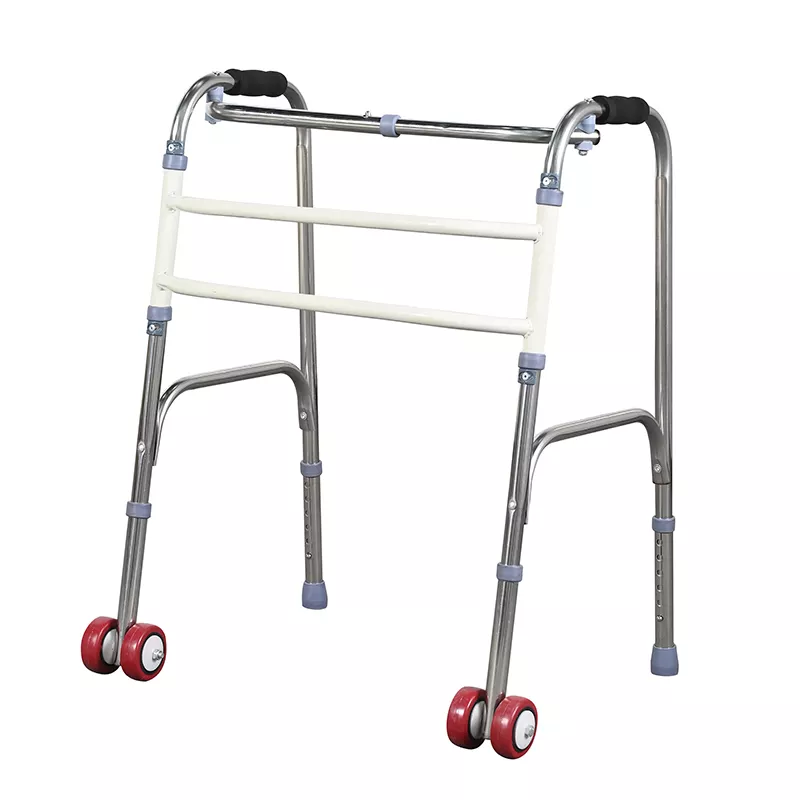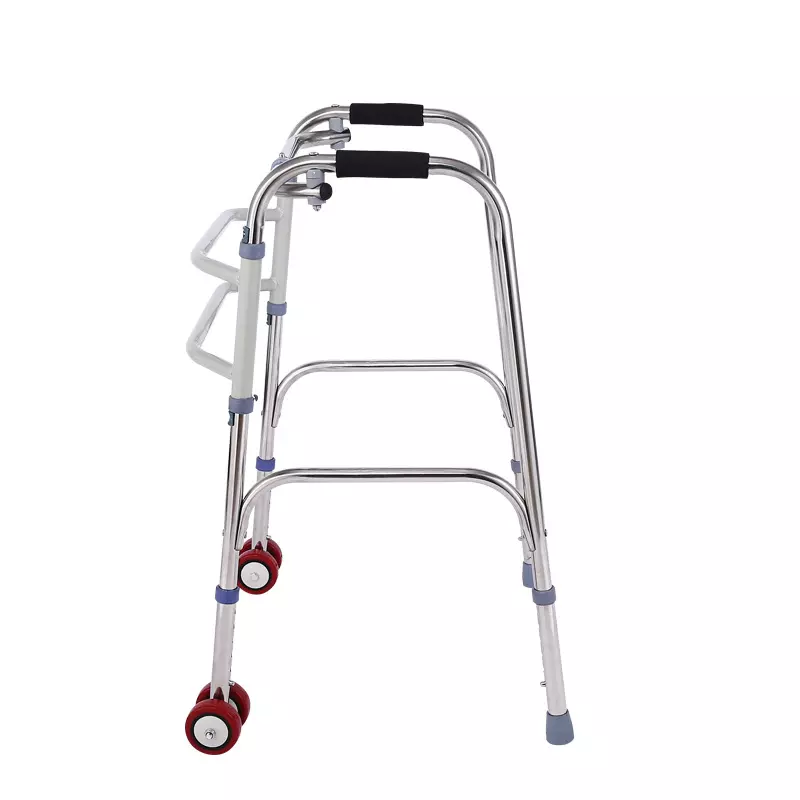2 Wheels Walker
| Product name | 2 Wheels Walker |
| Application | Hospital, Home, Clinic |
| Material | Stainless steel |
| Weight capacity | 100kg |
| Length between two handles | About 52cm |
| Total width | About 45cm |
| Total height | About 76-88cm |
| Packing size | 77*55*39cm, 6pcs/ctn |
| G.W. | 20kg |
What is a 2 Wheels Walker?
The lightweight 2 Wheels Walker is made of durable anodized aluminum and is equipped with 2 wheels in front. The two wheeled walkers can help people move easily indoors and outdoors. Suitable for people with limited walking ability, especially those with balance problems and those who are not strong enough to use a regular walker. The height of the walker is easily adjustable due to the buttons on each leg. The walker has rubber tips at the end of the feet, thus providing extra stability.
The role of walking aids
(1) Maintain balance: such as the elderly, non-central disorders of lower limb weakness, lower limb spasticity, poor extension, and unbalanced center of gravity movement, but it has little effect on balance disorders in elderly stroke and multiple cerebral infarction patients.
(2) Weight support: After hemiplegia or paraplegia, when the patient’s muscle strength is weakened or the weakness of the lower limbs cannot support the weight, or the patient cannot bear weight due to joint pain, the walker can play a substitute role.
(3) Enhance muscle strength: often use walking sticks and axillary sticks to support the body, so they can enhance the muscle strength of the extensor muscles of the upper limbs.
From the appearance point of view, walking aids in the sense of a plate do not include categories such as crutches and wheelchairs, but are divided into a separate category. Popularly speaking, they are also called walking aids and walkers. It has four legs without wheels(Standard Walker), four legs with two wheels(2 Wheels Walker), and four legs with four wheels(Rollator Walker).
How to use 2 Wheels Walker?
Many people have the misconception that wheelless walkers are safer, but that is an intuitive idea that is not scientific. People always think that the wheels will slip, so it is more dangerous. In fact, with two wheels in front, there will be active braking assistance at the back, and the wheels will pan and not fall over when pushed forward. On the contrary, a wheelless walker will tip over instantly when pushed forward, so every step forward will require lifting the walker, which will cause the body’s center of gravity to shake and make the overall walking process more unstable.
2 wheeled walkers are not too slow and do not need to be lifted
When using a walker, patients often press their bodies against the walker due to tension, which makes it easy for them to fall over if they are not careful. Many seniors give up walking because they can’t lift the walker, so let them try a walker with two wheels! They will find that by pushing forward with a steady force, they can easily move forward and pan, eliminating the troublesome step of lifting and speeding up.
Steps of walking with a wheelless walker
Lift the walker forward, step forward with one foot, follow with the other foot forward, and repeat the three steps above. With a two-wheeled walker, you can walk smoothly by holding the walker and pushing it forward. The user’s willingness to walk is greatly enhanced as the step of lifting the walker forward is eliminated and the walking speed can be nearly twice as fast. Adding two wheels to the walker allows the patient to walk more steadily and easily without the need to repeatedly lift and lower the walker, so that the back does not hurt and the hands do not get sore. The main point is that it will not slip as easily as imagined because of the design of the rear pillar, which will automatically brake immediately when pressed down easily.
For patients suffering from Parkinson’s disease, the use of two-wheeled walkers is particularly important because Parkinson’s patients have difficulties in starting their movements, and it takes a lot of effort to switch to a different movement mode each time.
There are large and small wheels for walker accessories, and the choice depends on the location where the user mainly uses the walker. Generally speaking, the small wheel is more suitable for indoor flat ground; while the large wheel can cope with outdoor rugged road; and the rear pillar directly with the original rubber pad walking, the most resistance.


